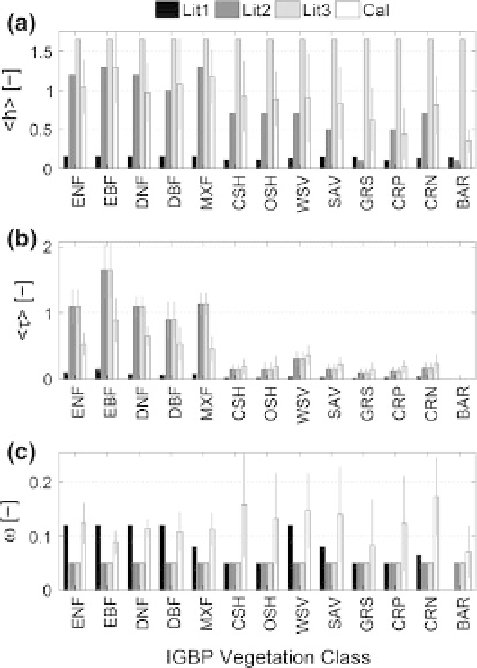Geoscience Reference
In-Depth Information
Fig. 6 a Time-mean \h[ (July
1, 2010-July 1, 2011), b time-
mean \s[, and c time-invariant
x;(Lit1, Lit2 and Lit3) before
calibration, and (Cal) after
calibration, spatially averaged by
vegetation class. International
Geosphere-Biosphere Program
(IGBP) vegetation classes are
(ENF) Evergreen Needleleaf
Forest, (EBF) Evergreen
Broadleaf Forest, (DNF)
Deciduous Needleleaf Forest,
(DBF) Deciduous Broadleaf
Forest, (MXF) Mixed Forest,
(CSH) Closed Shrublands, (OSH)
Open Shrublands, (WSV) Woody
Savannas, (SAV) Savannas,
(GRS) Grasslands, (CRP)
Croplands, (CRN) Cropland and
Natural Vegetation, and (BAR)
Barren or Sparsely Vegetated.
Thin gray lines for Cal indicate
the spatial standard deviation
within each vegetation class.
Adapted from De Lannoy et al.
(
2013
)
interference. The figure shows that all three sets of the literature values for the RTM
parameters lead to substantial biases against SMOS observations, with Lit1 being too cold
(by 42.0 K on average) and Lit3 too warm (by 24.6 K on average). Even though Lit2
estimates are nearly unbiased in the global average, there are still significant regional
biases in the simulated Tbs, with an average absolute bias of 12.7 K. Since such biases
would interfere with the assimilation of satellite Tb, the RTM parameters need to be
calibrated to achieve climatologically unbiased Tb simulations.
The most important RTM parameters determining h, s, and x have been calibrated,
separately for each model grid cell, using multi-angular SMOS observations from July 1,
2011 to July 1, 2012. The calibration simultaneously minimizes, separately for each
location, the difference between the modeled and observed climatological mean values, the
difference between modeled and observed climatological standard deviations, and the
deviations of the optimized parameters from prior guesses (that is, from Lit1, Lit2, or Lit3
values). Through investigating a number of calibration scenarios, De Lannoy et al. (
2013
)
determined that it is best to simultaneously calibrate a subset of the RTM parameters that
most directly determine h, s, and x.
After calibration, global Tb simulations for the validation year (July 1, 2010-July 1,
2011) are largely unbiased for multiple incidence angles and both H- and V-polarization.
For example, Fig.
7
d shows that the global average absolute bias is now just 2.7 K for
H-polarized Tb at 42.5 incidence angle. It should be emphasized that an RMSE of
approximately 10 K remains, which is partly due to seasonal biases and partly due to
random errors. The former will be addressed in the assimilation system through bias
estimation and correction, and the latter through the radiance-based soil moisture analysis.


